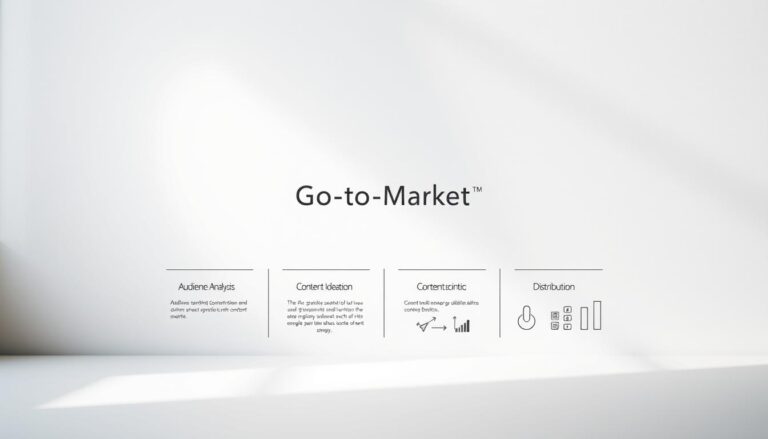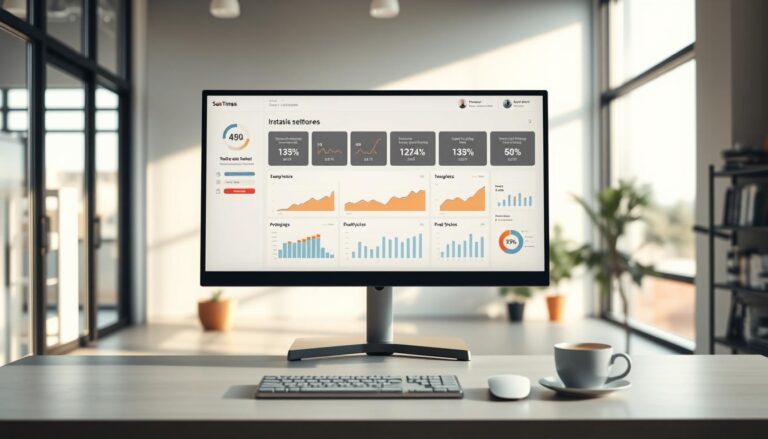Today’s quick-changing digital world shows how crucial Automated GTM Campaign Optimization is for businesses wanting to boost ROI. Using Google Tag Manager campaign tools helps manage campaigns easily and improves how well we track data and performance. With automation, companies can better use their Go-To-Market (GTM) technology, matching marketing with business aims. Industry insights tell us that focusing on a well-planned GTM strategy can greatly increase efficiency and returns on investments.
Looking into this topic, we see that automated methods can really change how marketing works. They make strategies more successful and focused on results.
Key Takeaways
- Automated GTM campaign optimization enhances campaign efficiency and accuracy.
- Utilizing Google Tag Manager campaign tools can streamline marketing processes.
- A structured GTM approach is essential for maximizing ROI.
- Automation supports data-driven decision-making in marketing strategies.
- Optimizing the technology stack can align marketing efforts with business objectives.
Understanding Automated GTM Campaign Optimization
Automated GTM campaign optimization uses tech to make marketing campaigns work better. It does this by managing marketing tags through a GTM tool. This makes tracking and analyzing easier, leading to more accurate and responsive campaigns.
What is Automated GTM Campaign Optimization?
It’s all about making Google Tag Manager automate tag management for marketing. It takes away the need for manual work, making data collection and analysis better. This helps in managing marketing campaigns automatically, ensuring they do well on all channels.
Importance of Automation in GTM
Automation in GTM is super important. It cuts down on manual work, reducing errors, and lets marketers make better strategic decisions. It also improves data accuracy, helping businesses make choices based on the latest information. By using a good GTM tool, businesses can make their campaigns perform better with less effort and higher returns.
Key Components of an Effective Campaign
To get automated GTM campaign optimization right, you need several important pieces:
- Clear Objectives: You must have clear goals for every campaign to know if it’s successful.
- Data Integration: It’s important that data from different sources work together in your GTM setup for a full analysis.
- Advanced Analytics: Using tools to understand your data better can help tweak your campaigns for the best results.
| Component | Description | Benefits |
|---|---|---|
| Clear Objectives | Defined goals for campaigns | Facilitates targeted strategies |
| Data Integration | Seamless data flow from multiple channels | Improves comprehensive performance analysis |
| Advanced Analytics | Tools for interpreting campaign data | Supports optimized decision-making |
Benefits of Automated Campaign Optimization
Automated campaign optimization offers many benefits for marketing teams aiming to improve their work. It makes processes smoother, improves analytics, and keeps track of results accurately. This way, traditional marketing methods get a big upgrade.
Increased Efficiency and Time Savings
Using automated tools in digital marketing makes work more efficient. It frees up time by doing repetitive tasks automatically. Then, marketing teams can use their time on big-picture strategies instead.
This shift towards focusing on strategy enhances productivity in the workplace.
Enhanced Data-Driven Decision Making
Automated tools help businesses make sense of lots of data. This data analysis lets marketing teams understand what works. These insights help guide their strategies and keep businesses adaptable.
Embracing these tools leads to better decisions and improves marketing efforts over time.
Improved Performance Tracking
Tracking the results of marketing campaigns gets much better with automation. Thanks to advanced analytics, businesses can see their metrics live. This lets them tweak campaigns as needed to do better.
Accurate tracking helps firms measure their ROI and fine-tune their approaches. This leads to more growth and success.

Setting Up Your Automated GTM Campaign
Starting an automated GTM campaign is all about the right steps. By building a strategic base, companies can make the most of GTM tools. We’ll cover the beginning steps, the must-have tools, and the top tips for success.
Initial Steps for Effective Implementation
To get Google Tag Manager campaigns right, begin with a deep dive into your current tech. Identify your marketing and analytics goals first. Next, set precise goals for what you want from your campaigns. Then, draw up a tracking plan that covers every tag and trigger you need.
Tools and Technologies for Optimization
GTM isn’t the only tool you’ll need, but it’s key. It works well with Google Analytics and Google Ads, helping you tweak campaigns with ease. Look into extra GTM tools for even better data gathering and analysis.
Best Practices for Configuration
Setting things up correctly makes a big difference. Make sure you test everything to keep tags working right. Use version control to avoid update problems, and document every step of your process. Keep checking and updating your setup to boost campaign success.
| Step | Description | Importance |
|---|---|---|
| Audit Tech Stack | Review existing technology and analytics setup. | Identifies gaps and areas for improvement. |
| Define Goals | Set specific objectives for campaigns. | Provides a clear direction for efforts. |
| Create Tracking Blueprint | Outline necessary tags, triggers, and variables. | Ensures comprehensive data collection. |
| Testing Procedures | Conduct thorough tests of configurations. | Validates functionality before launch. |
| Version Control | Maintain detailed records of changes made. | Prevents loss of important settings. |
| Regular Optimization | Reassess and improve campaign activities. | Keeps campaigns aligned with objectives. |
Measuring Success in Automated GTM Campaigns
To succeed in automated GTM campaigns, accurately measuring performance is key. Clear Key Performance Indicators (KPIs) are necessary for evaluating success. They include various metrics that show the effect of GTM analytics on marketing success.
Key Performance Indicators (KPIs)
Choosing the right KPIs is crucial for tracking success in automated GTM management. Important metrics include conversion rates, click-through rates, and the cost of acquiring customers. These give insight into how well a campaign is doing and what needs improvement.
Analyzing Campaign Performance Data
Analyzing campaign data turns raw numbers into useful insights. Tools and dashboards provide a complete view of campaign performance. This helps spot trends, oddities, and areas to better your GTM strategy.
Reporting and Continuous Improvement
Good reporting helps clearly communicate results. Using visuals helps make the data easier to understand and shows what’s working and what’s not. By leveraging these insights, organizations can improve their campaigns, creating a culture of learning and adapting. For more on making marketing automation better, check out this resource.

Challenges in Automated GTM Campaign Optimization
Using automated tools for marketing has its share of hurdles. It’s important to know these challenges for better results. Some issues include technical glitches and the need to keep up with laws on data privacy. Getting these right is crucial for the success of any campaign today.
Common Pitfalls to Avoid
It’s easy to depend too much on automation. Marketers should remember the power of human insight. This mix of technology and personal touch helps catch new trends and ideas. Be wary of these common mistakes:
- Neglecting customer feedback
- Ignoring A/B testing results
- Forgetting to update audience segments
Managing Technical Issues
Technical issues can throw a wrench in your campaign. Problems may arise from not integrating systems well or software glitches. To keep your campaign running smoothly, stay proactive. Things like regular checks and updates can prevent many issues.
Ensuring Data Privacy Compliance
Automated marketing must follow data privacy laws closely. This means knowing laws like GDPR and CCPA inside out. It’s key to use clear data collection methods and get users’ okays. A good data privacy plan can save you from huge fines and keep your reputation intact.
Advanced Techniques for Optimization
Optimizing GTM campaigns requires advanced techniques that boost performance. Each strategy offers unique benefits for better GTM campaign results. Using these methods can improve efficiency and outcomes significantly.
Utilizing Machine Learning Algorithms
Machine learning algorithms are key in optimizing GTM campaigns. They analyze lots of data to forecast outcomes and tweak campaigns as needed. With predictive analytics, companies can spot trends and react to market changes quickly. This helps make smart decisions that increase ROI.
Dynamic Budget Allocation
It’s crucial to use resources wisely in campaigns. Automated tools help adjust budgets automatically, putting more money into successful ads. This makes GTM campaign optimization more effective by concentrating resources where they work best.
A/B Testing and Multivariate Testing
A/B and multivariate testing refine marketing efforts. These tests compare ad versions to find what works best. A/B testing changes one thing at a time, whereas multivariate testing looks at several factors. They both play a big role in fine-tuning GTM campaigns by offering valuable insights.
| Technique | Description | Benefit |
|---|---|---|
| Machine Learning Algorithms | Analyze data to predict outcomes and adjust campaigns | Informed decision-making and responsiveness |
| Dynamic Budget Allocation | Adjust budgets based on real-time performance | Maximized ROI and efficient spending |
| A/B Testing | Compare two versions of an ad to determine effectiveness | Improved campaign performance |
| Multivariate Testing | Simultaneously test multiple variables for deeper insights | Optimized strategies based on comprehensive data |
Using these advanced methods improves automated GTM campaign optimization. This leads to ongoing growth and better engagement. For more tips on optimizing your campaigns, check out this resource.
Case Studies: Success Stories in GTM Optimization
Leading businesses have embraced automated GTM (Google Tag Manager) strategies. These strategies not only make marketing easier but also boost return on investment (ROI) greatly. The case studies discussed here reveal the creative tactics of different companies. They show how automated marketing campaign management can lead to success.
Industry Leaders and Their Strategies
Many companies have seen big improvements by automating their GTM campaign optimization. For example, a well-known e-commerce site greatly boosted its conversion rates. This was done by improving event tracking and managing data from one place. Using Google Tag Manager, they fixed more than 90% of events that were not recorded correctly before. This shows how crucial accurate event tracking is for reliable campaign data.
Lessons Learned from Successful Campaigns
These successful stories teach us important lessons:
- It’s critical to have one system for tracking to keep data consistent on all platforms.
- Checking event tracking regularly helps avoid errors and wrong reports.
- Using user ID tracking with Google Analytics 4 helps find who is buying while logged in.
Companies that used these methods improved their data accuracy. This led to better decisions.
Impact on ROI and Business Growth
The outcomes speak for themselves. Businesses that applied these automated marketing techniques saw incredible growth. They focused on better tracking and analytics, which led to high returns on their ad spend. To see a case study of this in action, look at The Sleep Factory’s success with Google Tag.
| Company | Strategy Implemented | Results Achieved |
|---|---|---|
| E-commerce Platform | Centralized event tracking and GTM optimization | Increased conversion rates, corrected tracking inaccuracies |
| Retail Brand | User ID tracking in GA4 | Higher identification of signed-in purchasers, better targeting |
Future Trends in Automated GTM Campaign Optimization
The future of automated GTM campaign optimization is rapidly changing. With the rise of artificial intelligence and data analytics, marketing is getting more effective. These tools allow companies to target specific customer groups more accurately than ever before.
Emerging Technologies Shaping the Landscape
Automation is entering a new phase thanks to recent tech advances. Predictive analytics and machine learning are becoming key for GTM campaign optimization. Tools like Breeze Intelligence and Jasper are revolutionizing how companies manage marketing. They make campaigns more efficient and content creation easier.
Predictions for the Next Five Years
In the next five years, marketing automation tools are expected to become even more advanced. Experts believe this will lead to more personalized interactions with customers and faster strategy changes. At the heart of this change is an improved customer experience, which will boost engagement and conversion rates.
Preparing for Future Changes in Marketing Automation
To stay ahead, companies must embrace new technologies now. They should train their teams, use the latest tools, and keep an eye on their performance. This proactive approach helps businesses not just keep up, but lead. For more on optimizing GTM campaigns with automation, check out this comprehensive guide.
FAQ
What is Automated GTM Campaign Optimization?
Automated GTM Campaign Optimization uses Google Tag Manager (GTM) technology to make marketing campaigns better. It automates tracking, analysis, and data integration. This boosts campaign effectiveness and ROI.
Why is automation important in GTM?
Automation is key in GTM because it cuts down on manual work, makes data more accurate, and helps marketers make fast, informed decisions. Automating tasks lets teams focus more on big-picture projects.
What are the key components of an effective automated GTM campaign?
For an effective campaign, you need clear goals, strong data integration, and advanced analytics. These help continuously optimize efforts based on insights.
How does automated campaign optimization enhance efficiency?
It boosts efficiency by reducing manual tasks. This frees up marketing teams to spend more time on strategic and creative work. It saves time and improves results.
What role does data-driven decision-making play in automated campaigns?
It’s vital because it uses insights from big data sets to improve strategies. This ups campaign effectiveness and ROI by analyzing real-time performance.
What are some initial steps for setting up an automated GTM campaign?
Start by checking your current tech, setting clear campaign goals, and making a tracking plan. This ensures you watch the right metrics.
What tools and technologies are crucial for GTM optimization?
You’ll need Google Tag Manager, Google Analytics, and data visualization tools. These help track and analyze performance.
How can success be measured in automated GTM campaigns?
Measure success with specific KPIs linked to your goals. Analyzing data regularly and refining strategies are key to staying effective.
What are common pitfalls to avoid in GTM optimization?
Watch out for relying too much on tools without human insight, not checking tracking accuracy, and ignoring data privacy laws like GDPR and CCPA.
How can emerging technologies influence GTM campaign optimization?
New tech, especially in automation and AI, will change GTM campaigns. They’ll bring predictive analytics, smart budget use, and better testing methods.



